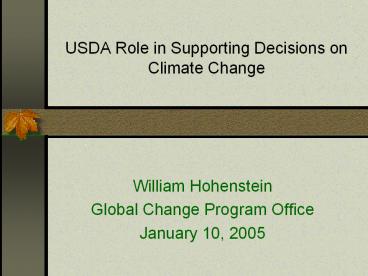USDA Role in Supporting Decisions on Climate Change - PowerPoint PPT Presentation
1 / 16
Title:
USDA Role in Supporting Decisions on Climate Change
Description:
USDA Role in Supporting Decisions on Climate Change William Hohenstein Global Change Program Office January 10, 2005 – PowerPoint PPT presentation
Number of Views:62
Avg rating:3.0/5.0
Title: USDA Role in Supporting Decisions on Climate Change
1
USDA Role in Supporting Decisions on Climate
Change
- William Hohenstein
- Global Change Program Office
- January 10, 2005
2
Federal Government Climate Change Policy
Development
3
(No Transcript)
4
What is Decision Support?
- the set of processes that includes
interdisciplinary research, product development,
communication, and operational services that
provide timely and useful information to address
challenges and questions confronting those who
need to make policy and/or resource management
decisionsthere is typically a premium on
timeliness, resolution, comprehensiveness and
effective communication of levels of scientific
confidence and uncertainty. - - CCSP Strategic Plan, 2003
5
Decision SupportThree CCSP Elements
- Scientific syntheses and assessments
- Adaptive management for resources and
infrastructure - Support for policymaking
6
Principal Guidelines for theCCSP Approach to
Decision Support
- Analyses structured around specific questions
- Early and continuing involvement of stakeholders
- Explicit treatment of uncertainties
- Transparent public review of analysis questions,
methods, and draft results - Evaluate ongoing CCSP analyses and build on
lessons learned
7
USDA Role
8
USDAs Climate Change Activities
- Implement actions under USDAs conservation
programs - Develop methods for estimating sources and sinks
from agriculture and forestry - Support voluntary agreements with the private
sector - MOU with the rural utilities
- Agreement with the American Forest and Paper
Association - Support the development of technologies and
practices - Implement Climate Change Science Program
Strategic Plan - Cooperate with the Department of State on
bilateral agreements
9
Chief Economist
Member of USDA Global Change Taskforce
10
Roles of the USDA Agencies
- ARS Assess potential impacts and
vulnerabilities to agriculture identifying
opportunities to respond and adapt develop
technologies and practices to mitigate greenhouse
gases - Forest Service Assess and manage potential
impacts on forest productivity, health,
disturbance processes, and species distributions
improve the information on carbon cycling and
inventories, provide landowner assistance. - CSREES Support the national UV-B monitoring
network provides competitive grants to assess
impacts oversee major soil carbon study. - NRCS Provide technical assistance to farmers
help farmers plan and implement conservation
systems maintain soil survey and associated
databases. - ERS Assess the economics of mitigation options
and impacts of climate change on well-being of
global and US agricultural producers and
consumers. - Others with roles FSA, RUS, International
Forestry, FAS, NASS
11
The Program is based on several widely accepted
facts.
- Weather extremes and climate variability are
major limitations to production. - Land use and land-use change affect the
environment, and vice-versa. - Crops are being produced in an atmosphere
containing a constantly increasing concentration
of CO2. - Crops and range plants are not alone in their
exposure to changes in weather, climate, and CO2. - Increasing soil carbon has broad environmental
benefits on and off the farm.
12
USDA Activities in the CCSP budget
In millions of dollars
USGCRP CCRI CCSP
Scientific Research 827 144 971
USDA 59 6 65
NASA Space-based Obs. 1,001 24 1,025
Total 1,828 168 1,996
Source Our Changing Planet 2004
13
Human Contributions and Responses Nutrient
management and precision agriculture
- The U.S. emitted 20 MMTCE from fertilizer and
manure land application - USDA/ARS is building a national network called
GraceNET to evaluate alternative management
practices
14
Decision Support Carbon dioxide affects
glyphosate efficacy in the field.
Ambient CO2
2 x CO2
15
Presidential directives to USDA
- In February, 2002, the President directed
Secretary Veneman to - Provide recommendations on targeted incentives
for forest and agricultural sequestration of
greenhouse gases - Develop accounting rules and guidelines for
crediting carbon sequestration projects, in
consultation with DOE and EPA
16
Greenhouse gases have been incorporated into USDA
Conservation Programs
- Environmental Quality Incentives Program (EQIP)
- NRCS provided national guidance to make GHG a
priority resource concern. - New practice standards for digesters announced in
2003. - Tiered payments under EQIP will reward producers
who improve nutrient management - Conservation Reserve Program (CRP)
- Secretary Veneman announced that USDA would
target 500,000 acres (226,000 ha) of bottomland
hardwoods under the CRP continuous sign-up - FSA providing points for carbon sequestration in
rating CRP proposals through the Environmental
Benefits Index (EBI). - Conservation Innovation Grants (CIG)
- A competitive grants program administered by NRCS
- Provides opportunities to accelerate the
development, transfer and adoption of innovative
technologies and approaches for agriculture.































